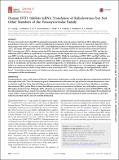Human IFIT1 inhibits mRNA translation of rubulaviruses but not other members of the Paramyxoviridae family
Abstract
We have previously shown that IFIT1 is primarily responsible for the antiviral action of interferon (IFN) alpha/beta against parainfluenza virus (PIV) type 5, selectively inhibiting the translation of PIV5 mRNAs. Here we report that whilst PIV2, PIV5 and mumps virus (MuV) are sensitive to IFIT1, non-rubulavirus members of the paramyxoviridae such as PIV3, Sendai virus (SeV) and canine distemper virus (CDV) are resistant. The IFIT1-sensitivity of PIV5 was not rescued by co-infection with an IFIT1-resistant virus (PIV3), demonstrating that PIV3 does not specifically inhibit the antiviral activity of IFIT1 and that the inhibition of PIV5 mRNAs is regulated by cis-acting elements. We developed an in vitro translation system using purified human IFIT1 to further investigate the mechanism of action of IFIT1. Whilst the translation of PIV2, PIV5 and MuV mRNAs were directly inhibited by IFIT1, the translation of PIV3, SeV and CDV mRNAs were not. Using purified human mRNA capping enzymes we show biochemically that efficient inhibition by IFIT1 is dependent upon a 5’ guanosine nucleoside cap (which need not be N7-methylated) and that this sensitivity is partly abrogated by 2’ O methylation of the cap 1 ribose. Intriguingly, PIV5 M mRNA, in contrast to NP mRNA, remained sensitive to inhibition by IFIT1 following in vitro 2’ O methylation, suggesting that other structural features of mRNAs may influence their sensitivity to IFIT1. Thus, surprisingly, the viral polymerases (which have 2’ -O-methyltransferase activity) of rubulaviruses do not protect these viruses from inhibition by IFIT1. Possible biological consequences of this are discussed. Importance Paramyxoviruses cause a wide variety of diseases and yet most of their genes encode for structural proteins and proteins involved in their replication cycle. Thus the amount of genetic information that determines the type of disease paramyxoviruses cause is relatively small. One factor that will influence disease outcomes is how they interact with innate host cell defences, including the interferon (IFN) system. Here we show that different paramyxoviruses interact in distinct ways with cells in a pre-existing IFN-induced antiviral state. Strikingly, all the rubulaviruses tested were sensitive to the antiviral action of ISG56/IFIT1, whilst all the other paramyxoviruses tested were resistant. We developed novel in vitro biochemical assays to investigate the mechanism of action of IFIT1, demonstrating that the mRNAs of rubulaviruses can be directly inhibited by IFIT1 and that this is at least partially because their mRNAs are not correctly methylated.
Citation
Young , D F , Andrejeva , J , Li , X , Inesta-Vaquera , F , Dong , C , Cowling , V H , Goodbourn , S & Randall , R E 2016 , ' Human IFIT1 inhibits mRNA translation of rubulaviruses but not other members of the Paramyxoviridae family ' , Journal of Virology , vol. 90 , no. 20 , pp. 9446-9456 . https://doi.org/10.1128/JVI.01056-16
Publication
Journal of Virology
Status
Peer reviewed
ISSN
0022-538XType
Journal article
Description
This work was supported by The Welcome Trust (101788/Z/13/Z, 101792/Z/13/Z) and Medical research council grant (G1100110/1, MR/K024213/1).Collections
Items in the St Andrews Research Repository are protected by copyright, with all rights reserved, unless otherwise indicated.

